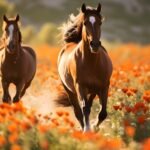Recognizing and addressing health issues in horses is crucial for their well-being and performance. One common ailment that can affect horses is thrush, a fungal infection of the frog, the triangular, rubbery part of the hoof. Prompt identification and treatment of thrush are essential to prevent complications and ensure the horse’s hoof health.
Understanding Thrush
Thrush is a contagious fungal infection that thrives in warm, moist environments. It primarily affects the frog, but can also spread to the surrounding hoof tissues. The infection causes a foul-smelling discharge, often described as having a “rotten egg” odor, and can lead to lameness, pain, and even hoof damage if left untreated.
Why Early Identification Matters
Early detection of thrush is crucial because it allows for timely intervention and prevents the infection from worsening. Untreated thrush can lead to:
- Deepening of the frog
- Separation of the frog from the hoof wall
- Abscess formation
- Lameness and difficulty moving
By recognizing the signs of thrush and seeking veterinary care, horse owners can protect their animals from these potentially serious consequences.
How To Identify Thrush In Horses
Thrush is a common and often painful hoof condition that affects horses. It is caused by an overgrowth of a type of fungus called Aspergillus niger, which thrives in a warm, moist environment. Identifying thrush early is crucial for effective treatment and preventing complications. This article will guide you through the steps of identifying thrush in horses.
Understanding Thrush
Thrush typically affects the frog, the triangular-shaped, elastic tissue on the underside of the hoof. The fungus feeds on the dead tissue in the frog, causing inflammation, softening, and a foul odor. If left untreated, thrush can spread to the surrounding hoof tissues, leading to lameness, abscesses, and even permanent hoof damage.
Symptoms of Thrush
Recognizing the signs of thrush is the first step in providing your horse with the necessary care. Look out for the following symptoms:
- A foul odor emanating from the frog, often described as like rotten eggs.
- Soft, mushy, or discolored frog tissue that may appear dark brown, black, or even yellowish.
- Visible debris or sloughing of tissue from the frog.
- Increased sensitivity when pressure is applied to the frog.
- Lameness, particularly when walking on hard surfaces.
Identifying Thrush in Different Stages
Thrush progresses through stages, each with distinct characteristics: (See Also: What Food Do Horses Eat In Minecraft)
Early Stage
In the early stages, the frog may appear slightly discolored and a mild odor may be present. The frog tissue is still relatively firm.
Moderate Stage
As thrush progresses, the frog becomes increasingly soft and mushy. The odor intensifies, and you may notice visible debris or sloughing of tissue.
Advanced Stage
In advanced cases, the frog tissue is severely damaged, and the odor is extremely strong. The horse may exhibit significant lameness and reluctance to move.
Diagnosing Thrush
While the symptoms mentioned above can often indicate thrush, a veterinarian should be consulted for a definitive diagnosis. They will examine the hoof, assess the condition of the frog, and may take a sample for laboratory analysis to confirm the presence of the fungus.
Preventing Thrush
Preventing thrush is essential for maintaining your horse’s hoof health. Here are some key steps:
Maintain Cleanliness
Regularly clean your horse’s hooves, paying particular attention to the frog area. Remove any dirt, mud, or debris that can trap moisture and create a favorable environment for fungal growth.
Dry the Hooves Thoroughly
After cleaning, ensure the hooves are completely dry. Moisture promotes fungal growth, so it’s important to allow the hooves to air dry or use a hoof dryer. (See Also: What Do Wild Horses Do About Their Hooves)
Provide Adequate Ventilation
Ensure your horse’s stable or paddock has good ventilation to reduce humidity levels. Damp environments are more conducive to thrush development.
Trim Hooves Regularly
Regular hoof trimming by a qualified farrier helps maintain the shape and balance of the hooves, promoting healthy frog function and reducing the risk of thrush.
Consider Hoof Supplements
Some hoof supplements, such as biotin, may help strengthen the hoof wall and improve overall hoof health, potentially reducing the susceptibility to thrush.
Recap
Thrush is a common hoof condition in horses that can cause pain and lameness if left untreated. Early identification is crucial for effective management. By understanding the symptoms, stages, and preventive measures, horse owners can play a vital role in keeping their horses’ hooves healthy and thrush-free.
Remember, if you suspect your horse has thrush, consult a veterinarian for a proper diagnosis and treatment plan.
Frequently Asked Questions About Thrush in Horses
What is thrush in horses?
Thrush is a bacterial infection that affects the frog, the V-shaped, rubbery part of a horse’s hoof. It’s characterized by a foul-smelling discharge, often black or grayish in color, and can cause lameness and pain. (See Also: Why Do The Horse Guards Slap Their Horses)
What causes thrush in horses?
Thrush is primarily caused by a buildup of moisture and debris in the frog, creating an ideal environment for bacteria to thrive. Factors like wet conditions, poor hoof hygiene, and inadequate trimming can contribute to its development.
How can I tell if my horse has thrush?
Look for a dark, foul-smelling discharge from the frog. The frog may appear soft, mushy, and inflamed. Your horse might also exhibit lameness, reluctance to move, or sensitivity when the frog is touched.
What should I do if my horse has thrush?
It’s important to consult with a veterinarian for diagnosis and treatment. They may recommend cleaning the frog thoroughly, applying antifungal medications, and addressing any underlying hoof issues.
How can I prevent thrush in horses?
Regular hoof cleaning and trimming are crucial for prevention. Keep the frog dry and free of debris. Provide your horse with a clean, dry environment and ensure proper nutrition and overall hoof health.


